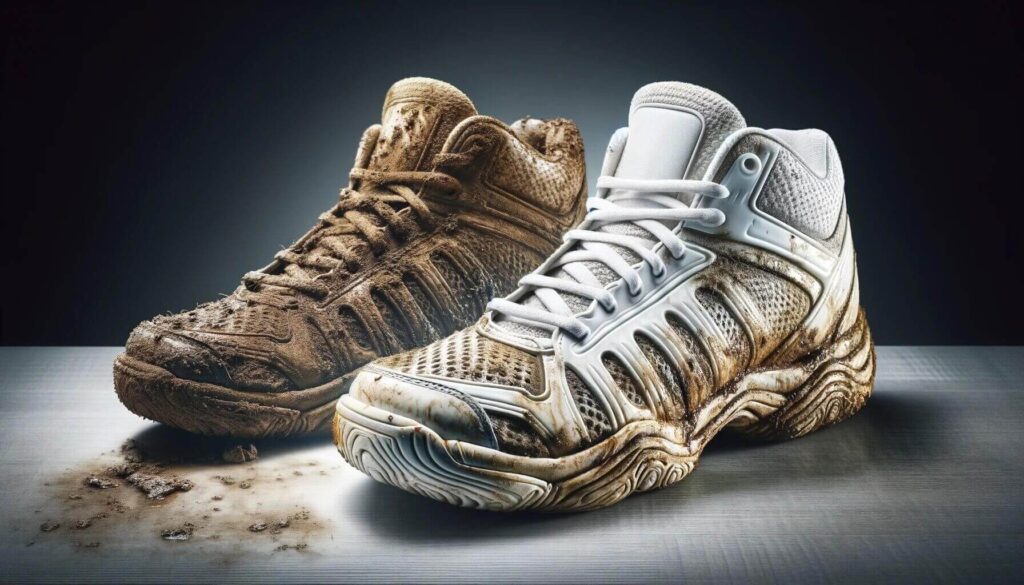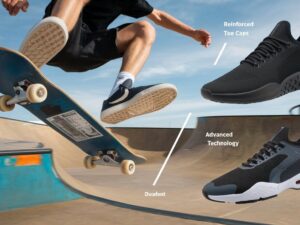Table of Contents
ToggleHow to Care for Your Volleyball Shoes for Best Performance

Volleyball isn’t just a sport to me; it’s a way of life. The thrill of the game, the teamwork, and the sheer joy of a perfect spike make every moment on the court unforgettable. But to play my best, I’ve learned that the right gear is key.
And nothing is more crucial than my volleyball shoes. These aren’t just any shoes; they’re my foundation, my support, and sometimes, my secret weapon. They help me move faster, jump higher, and land safer.
“Clean shoes tread long miles; care for them, and they’ll carry you through every game.”
This guide is all about giving your volleyball shoes the love they deserve. I’ll share simple, yet effective tips to keep them in top shape, ensuring they’re always ready to support your next big play. Whether you’re diving for a save or jumping for a block, your shoes will be there for you, performance-ready.
Let’s dive into making sure your shoes can keep up with your passion for the game. Stick with me, and let’s take the first step together towards unleashing the full potential of your volleyball shoes.
Understanding Your Volleyball Shoes
Picking the right volleyball shoes was a game-changer for me. I remember trying on pair after pair, looking for that perfect fit. It wasn’t just about the look; I needed shoes that felt like they were made just for me. Comfort was key because nobody wants sore feet in the middle of a game. Support was another big deal.
My shoes had to hug my feet in all the right places, so I could move fast and stay steady without worrying about twists or slips. And they had to be tough. Volleyball can be rough, and I didn’t want shoes that gave up before I did.
What makes volleyball shoes special, though, goes beyond just feeling good. It’s all about the sole, cushioning, and material. The sole needs to grip the floor just right, so you can jump, land, and sprint without slipping.
The cushioning is like a secret superpower. It absorbs the shock every time I land from a spike, protecting my knees and ankles. And the material matters more than you might think. I need to let my feet breathe because nobody plays well with sweaty, hot feet.
Taking care of my volleyball shoes is a big deal for me. It’s not just about making them last longer, though that’s a nice bonus. It’s about keeping those special features working their best. Clean, well-cared-for shoes mean I get the grip, comfort, and support I need every time I play. It’s like making sure your car is well-oiled and running smoothly. You wouldn’t ignore an alert light on your dashboard, right? Well, I treat my volleyball shoes the same way. Looking after them means they’re always ready to help me play my best game.
Daily Care Routine
After every game or practice, I’ve got a simple routine that keeps my volleyball shoes in top shape. Let’s dive into the steps I take to keep them clean, dry, and ready for action. It’s not just about the look; it’s about ensuring they last longer and perform better every time I hit the court.
Step 1: Knock Off the Dirt
As soon as I’m done playing, I knock my shoes together outside to get rid of any loose dirt or sand. You’d be surprised how much stuff clings on during a match. This little action helps a lot in keeping the indoors clean and the shoes in good condition.
Step 2: Wipe Them Down
Next up, I grab a soft cloth or a gentle brush. Using a bit of water and a mild soap, I carefully wipe down the outside of the shoes. This step is crucial for removing the sweat and dirt that’s built up. I’m always gentle, especially over the areas with more wear, to avoid damaging the material.
Step 3: Pull Out the Insoles
This might seem like a small step, but it’s a game-changer. Pulling out the insoles helps them dry out faster and more thoroughly, preventing any nasty smells or bacterial growth. It also gives me a chance to check if they’re still in good shape or if they need replacing.
Step 4: Air Dry the Right Way
I never throw my shoes in the dryer. Instead, I let them air dry in a well-ventilated area, but not directly in the sun. Direct sunlight can warp the shape and fade the colors. So, I find a nice, shady spot where air can circulate freely inside and around them. This step is crucial for preventing odor and keeping the shoes fresh.
Tools and Products I Recommend:
A soft cloth or a soft-bristle brush for cleaning.
Mild soap – nothing too harsh that might damage the shoe material.
A shoe deodorizer spray that’s safe for athletic shoes. It’s a lifesaver for keeping them smelling fresh, especially if you play often.
For stubborn stains or deeper cleans, I use a shoe cleaner designed for athletic shoes. These are formulated to be tough on dirt but gentle on the shoe’s materials.
Remember, the key to this routine is consistency. Making it a part of your post-game or practice habits can extend the life of your shoes significantly, ensuring they’re always ready to support your best performance.
Plus, it’s a great way to take care of the gear that takes care of you on the court. Happy cleaning, and here’s to many more successful matches in your fresh, well-cared-for volleyball shoes!
Deep Cleaning Method
Every month, I give my volleyball shoes a deep clean. Let me walk you through my deep cleaning ritual, step by step.
Step 1: Prep Work
First off, I take out the insoles and laces. These parts need special attention, and removing them makes the rest of the cleaning process more thorough. Plus, it’s easier to get into all the nooks and crannies this way.
Step 2: Clean the Insoles
Insoles can get pretty sweaty and dirty, so I wash them separately. I use a mix of mild soap and water, gently scrubbing them to remove any odor and dirt. After rinsing them well, I put them aside to dry.
Step 3: Laces Out
The laces come next. I immerse them in a solution of soap and water. Sometimes, if they’re grimy, I’ll rub them between my hands or use a soft brush. Then, I rinse them out and hang them to dry. If they’re too worn out, I replace them—it instantly refreshes the look of the shoes.
Step 4: The Main Event – Washing the Shoes
Now, for the shoes themselves. I use a soft brush and a gentle cleaner made for athletic shoes. Starting with the outside, I work up a light lather, being careful around any mesh or fabric parts to avoid damage.
For the inside, I use a sponge to lightly scrub, ensuring I remove sweat and dirt buildup. After they’re cleaned, I rinse them with a damp cloth, making sure no soap residue is left.
Step 5: Drying
Drying is crucial. I never use a dryer or direct heat, as it can warp the shoes. Instead, I stuff them with paper towels to absorb moisture and maintain their shape. Then, I leave them in a well-ventilated area away from direct sunlight.
Sometimes, I’ll put them near a fan to speed up the drying process gently. This method ensures they dry evenly without damaging the material or structure.
Extra Tips:
- Always test your cleaner on a small, inconspicuous area of the shoe first to make sure it doesn’t cause any damage.
- If your shoes are extra smelly, sprinkling baking soda inside them before the cleaning process can help absorb odors.
- Consider using a water-repellent spray after they’re dry, especially if you often play in humid conditions. This can help protect them from getting too wet in the future.
This monthly ritual keeps my volleyball shoes in top condition, ready to tackle any game. It might seem like a bit of work, but believe me, it’s worth it.
Not only do my shoes last longer, but they also continue to provide the support and comfort I need on the court. Give it a try, and see how it transforms your volleyball shoes—and maybe even your game!
Storage and Transportation
Storing and transporting my volleyball shoes might not sound like the most exciting part of the game, but trust me, it’s a game-changer. Keeping them in great shape isn’t just about cleaning; how you store and carry them matters a lot.
Let’s dive into my simple but effective strategies for making sure my shoes stay ready for action, whether it’s game day or practice time.
Storing Your Shoes The Right Way
After a long match or an intense practice session, I make sure my shoes have a special spot at home. This isn’t just about tidiness; it’s about preserving their shape and preventing any unnecessary damage. Here’s how I do it:
1 Air Them Out: First, I always air them out. If they’re still a bit sweaty or damp, I let them breathe in a well-ventilated area but away from direct sunlight. This helps to avoid any moisture build-up, which can lead to odor or worse, mold.
2. Stuff Them with Newspaper: To keep their shape, I gently stuff my volleyball shoes with newspaper. This simple trick absorbs any leftover moisture and helps the shoes maintain their original form. Plus, it’s a great way to recycle those old papers!
3. Use a Shoe Rack: I have a dedicated spot on my shoe rack for my volleyball shoes. Keeping them off the ground protects them from getting squished or lost among other shoes. Plus, it keeps them at the ready for whenever I need them next.
Transporting Shoes Like a Pro
Getting my volleyball shoes to and from the court safely is just as crucial. Here’s how I make sure they survive the trip without any extra wear and tear:
1. Breathable Bags Are Key: I never just throw my shoes into my gym bag with everything else. Instead, I use a breathable shoe bag. These bags are fantastic because they let air circulate, preventing moisture from getting trapped inside after a sweaty game.
2. Keep Them Separate: I always keep my volleyball shoes separate from my other gear. This avoids any accidental damage from heavier items and keeps them clean. Plus, it makes grabbing them for a quick game or practice a breeze.
3. Avoid Squishing: In my bag, I make sure my shoes are in a spot where they won’t get squished. Keeping their shape is essential for when I hit the court again. A squished shoe can lead to discomfort or even injury, and we definitely don’t want that.
By following these simple storage and transportation tips, I’ve managed to extend the life of my volleyball shoes significantly. It’s all about giving them a little TLC off the court, so they’re ready to perform when it’s game time.
Remember, taking care of your shoes is just as important as practicing your serves and spikes. With these strategies, your volleyball shoes will not only last longer but also support your feet better, game after game.
When to Repair or Replace
Knowing when to repair or replace your volleyball shoes can feel like a guessing game, but trust me, some signs tell you exactly what to do. Over the years, I’ve learned to spot these signs and make the smart choice.
Let’s walk through my experiences and what I’ve learned about keeping my footwear in top-notch condition.
Spotting Wear and Tear
The first time I noticed the sole of my shoe starting to flatten and lose its grip, I knew something was up. This was my first clue. The grip on your volleyball shoes is like your best buddy on the court; when it starts to go, you might find yourself slipping more often.
Another sign? Small tears in the top material or the toe area. Volleyball involves a lot of quick movements, and these parts of the shoe take a beating.
Repair or Replace?
Here’s how I decided:
1. Minor Sole Wear: If it’s just minor wear on the sole and the grip isn’t totally gone, I sometimes opt for a professional repair. A good shoe repair shop can work wonders and give your shoes a bit more life.
2. Small Tears: For small tears, especially if they’re just cosmetic, a bit of shoe glue can be a quick fix. But, if those tears are deep or affecting the shoe’s structure, it’s a different story.
3. Major Issues: When the cushioning starts feeling flat and doesn’t bounce back, or if the support isn’t what it used to be, it’s time for a new pair. These are signs that the shoe’s integrity is compromised, and no repair will bring back the performance you need.
Typical Lifespan of Volleyball Shoes
The lifespan of your volleyball shoes can vary based on how often you play. Here’s a rough guide based on my experience:
Casual Player (once a week): Your shoes could last a year or even longer since they’re not facing daily stress.
Regular Player (2-4 times a week): Six to nine months is a good benchmark. The constant use wears down the shoes faster.
Intense Player (almost daily): You’re looking at needing new shoes every 3-6 months. The wear and tear from daily play are significant.
Remember, these are just guidelines. The key is to pay attention to how your shoes feel and perform. If you start noticing that your movements aren’t as sharp or your feet feel more tired after a game, it might be time to inspect your shoes closely.
In the end, knowing when to repair or replace your volleyball shoes comes down to being in tune with your footwear. By paying attention to the signs of wear and tear and understanding the impact on your play, you’ll make the right call.
And always remember, investing in a good pair of shoes is investing in your performance on the court. Keep them in good shape, and they’ll take care of you game after game.
Performance Tips
Taking care of my volleyball shoes isn’t just about making them last longer; it’s about keeping my game sharp. When my shoes are in top condition, I move better, jump higher, and play harder.
Here’s how caring for my shoes directly boosts my performance on the court:
Better Grip, Better Moves: Regularly cleaning the soles of my shoes keeps the grip strong. This means I can make those quick turns and sudden stops without slipping. A good grip gives me the confidence to push my limits and go for those tough plays.
Comfort Means Energy: By keeping my shoes clean and dry, they stay comfortable. Uncomfortable shoes can be a distraction and slow me down. But when my feet are happy, I can focus on the game, saving my energy for those intense moments.
Here’s my advice for keeping your shoes ready to perform:
Dry Them Out: Always let your shoes dry naturally after a game. Moisture can mess with the shoe’s interior and weaken its structure, affecting how well you can move and jump.
Keep Them Clean: A clean shoe is more than just about looks. Dirt and grime can degrade the materials, affecting both comfort and performance. Regular cleaning keeps them functional and feeling new.
Check the Fit: Even well-cared-for shoes can start to stretch and lose their shape over time. A good fit is crucial for support and agility on the court. If your shoes feel loose, it might be time for an adjustment or a new pair.
Taking care of my volleyball shoes is a key part of my routine. It’s simple: well-maintained shoes lead to better performance. So, give your shoes some love, and they’ll pay you back on the court!
Closing Remarks
So, we’ve taken a journey through the game-changing world of shoe care. Keeping your volleyball shoes in peak condition isn’t just about looking good; it’s about playing good. A clean, well-maintained shoe means you grip better, move faster, and play harder.
“Remember, great shoes carry you to victory, but only if you keep them clean and ready for the game.”
I challenge you to make shoe care a part of your routine. It’s a simple step that can lift your game to new heights. Imagine stepping onto the court, shoes fresh, grip tight, and feeling unstoppable. That’s the power of proper shoe care.
Let’s remember, excellence in volleyball starts from the ground up. Your shoes are your foundation, your silent supporters in every jump, sprint, and dive. Treat them well, and they’ll return the favor on the court.
So, here’s to pushing limits, breaking boundaries, and reaching for the stars, all with a pair of well-cared-for volleyball shoes. Let’s not just play the game; let’s win it, one step at a time. Keep your shoes game-ready, and you’ll be game-ready too. Let’s face it, team!
FAQs
Cleaning your shoes removes dirt and sweat that can wear down the material, keeping them in top condition for better performance.
Use a soft brush or cloth with mild soap and water. Avoid harsh chemicals that can damage the shoes.
It’s not recommended as it can damage the shoe’s material and structure. Stick to hand washing.
Air them out after each use, and sprinkle baking soda inside overnight to absorb odors.
Store them in a cool, dry place away from direct sunlight. Use a shoe bag or box to protect them from dust.
It’s best to use specific shoes for each environment to prevent wear and maintain grip.
Checking the soles helps you know when they are worn out and need replacing to maintain your performance and safety.




